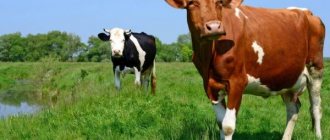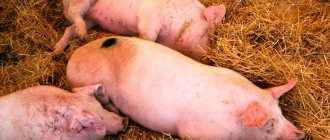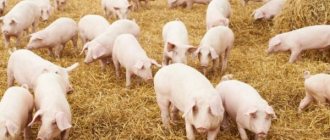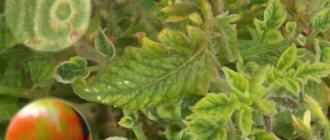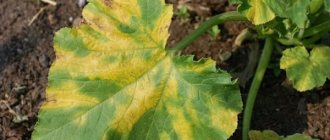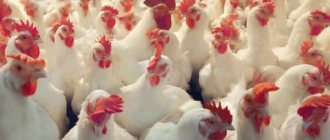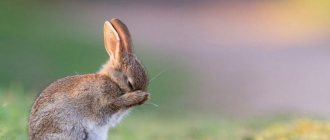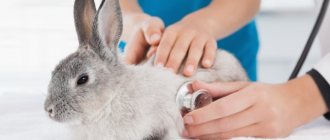Gastrointestinal nematodes (roundworms)
Most nematodes live in the intestines of pigs. However, there are also those that affect the heart, lungs, kidneys, liver and other organs.
Ascaris suum (pork roundworm)
Pork roundworm (Ascaris suum) in feces.
Live in the small intestine Distribution . This is a type of roundworm that infects pigs around the world, causing ascariasis. The prevalence is often very high, especially in tropical countries. Studies in Canada have shown that more than 60% of pigs are infected with this worm.
What does it look like? Ascaris suum are fairly large worms that resemble earthworms. They can be up to 50 cm long and up to 6 mm thick, and have a whitish color. Females are larger than males. The parasites' mouth has three lips with numerous small teeth. Like other roundworms, the body of this helminth is covered with a cuticle, which is flexible but quite rigid. The eggs of the parasite are oval in shape, approximately 40x60 microns, brownish-yellowish in color, with a dense membrane and a rough surface.
Routes of infection . The direct life cycle of the pig roundworm does not include any intermediate hosts. Pigs become infected by ingesting eggs that have matured under favorable conditions in the soil, along with food or water.
Symptoms and consequences . The damage caused by larval migration is significant. Mass transfer to the lungs can cause pneumonia, bleeding, edema, emphysema, etc. The disease is accompanied by a secondary bacterial infection, manifested by typical respiratory symptoms (cough, difficulty breathing, etc.). A few adult worms in the intestines are relatively harmless. But in large numbers they can block the lumen of the intestine or bile ducts, causing perforation and peritonitis. Infection with roundworms can also exacerbate infectious diseases such as swine flu. Ascaris suum can be fatal. Young animals are especially susceptible to infection.
Genus Globocephalus
Adult Globocephalus urosubulatu worms in the small intestine of a pig
Distribution . Mainly Europe, Asia and Africa. Representatives of this genus are parasites of domestic pigs and wild boars. The most significant species is Globocephalus urosubulatus.
What does it look like? Adult Globocephalus worms are quite small - 6-8 mm in length (females are larger). Worms do not have any external signs of segmentation, i.e. the body is completely smooth and, like other nematodes, is covered with a cuticle. The eggs are 35x60 µm in size, covered with a thin membrane and contain 4-8 cells when passed in the feces.
Routes of infection . Not fully studied, but most likely there are no intermediate hosts. Most likely, the larvae emerge from the eggs after 8-12 days outdoors or even indoors. They are then ingested by pigs, but piglets can also become infected through the skin. The larvae are susceptible to environmental conditions and do not survive in direct sunlight and low temperatures.
Symptoms and consequences . Infections in pigs caused by these worms are infrequent, but in cases of mass infestation they can have serious consequences in endemic areas. The worms attach to the intestinal lining to suck blood, causing numerous small bleeding lesions on the lining. In pigs, digestion is impaired, and as a result, weight gain decreases or even weight loss is observed. This is accompanied by anemia and hypoproteinemia.
Genus Gnathostoma
Gnathostoma spinigerum.
They are immediately localized deep in the walls of the stomach, or before this they undergo a long migration throughout the entire body Distribution . G. hispidum and G. spinigerum infect pigs and wild boars in Europe, Asia, Africa and Australia and South America in regions with warm, humid climates. Wild boars suffer more than domestic pigs. The highest incidence of the disease is observed in tropical and subtropical areas of Asia (eg, Thailand, Japan, China).
What does it look like? Adult worms are medium-sized (from 10 to 50 mm in length), brownish-reddish in color. The body is covered with a cuticle, which is flexible but quite rigid. It is equipped with spines located along the entire body. Helminths have a tubular digestive system that begins with the mouth and ends with the anus. Males have a chitinous spicule for attachment to the female during mating. The eggs are quite large (40x70 microns), oval in shape.
Routes of infection . Pigs become infected by eating second definitive hosts - fish, frogs or snakes.
Symptoms and consequences . In pigs, infections with multiple worms generally do not cause any clinical signs. Massive parasitism can lead to inflammation of the stomach (gastritis), which leads to weight loss, as well as developmental delays in piglets.
Hyostrongylus rubidus (red stomach worm)
Adult Hyostrongylus rubidus passed in stool
Distribution . The helminth Hyostrongylus rubidus, also called Red stomach worms, is found throughout the world, but incidence varies greatly depending on region.
What does it look like? Hyostrongylus rubidus are fairly small worms, usually no more than 10 mm, with a reddish tint. Females are slightly larger than males. Like other roundworms, their body is covered with a cuticle, which is flexible and tough. The digestive system is tubular, there is a mouth and an anus. There is no circulatory or excretory system. Eggs – 35×65 microns, with a thin shell.
Ways of infection . The mechanism of infection is direct - the eggs are released with feces and, after maturation, are ingested by pigs. These worms mainly affect pigs kept outdoors, as this environment is better for egg maturation than indoors. Sows are at particular risk under these conditions.
Symptoms and consequences . Infections in adult animals usually resolve without symptoms. Sometimes there is poor appetite and weight loss. Adult worms suck blood and irritate the walls of the stomach, which can lead to catarrhal gastritis. Massive infections can be fatal in young animals. Loss of appetite, anemia and diarrhea are also signs of infection.
Mecistocirrus digitatus
Mecistocirrus digitatus.
They live in the stomach, attaching to its walls Distribution . Mecistocirrus digitatus are nematodes found in tropical and subtropical regions of Central and South America, Africa, and Asia. Incidence varies locally and seasonally.
What does it look like? An adult Mecistocirrus digitatus reaches up to 4 cm in length, with females being larger than males. The body is covered with a tough and flexible cuticle with 30 longitudinal ridges. The internal structure is similar to other roundworms. Eggs – 70×110 microns, with a thin shell.
Routes of infection . Pigs become infected after eating the larvae while grazing. There are no intermediate hosts.
Symptoms and consequences . Mecistocirrus digitatus damages the stomach lining to gain access to blood. Acute symptoms include darkening of the stool, abdominal, thoracic and submandibular edema. Chronic infections often lead to iron deficiency anemia, periodic constipation, loss of appetite and weight, and gradual exhaustion of the body.
Genus Oesophagostomum
Oesophagostomum larvae mature in the intestinal walls, forming nodules within a week.
Then they migrate to the large intestine and live there, and the abandoned nodules become hemorrhagic. Spreading . Oesophagostomum is a genus of parasitic roundworms. It is more common in hot and humid climates, tropical and subtropical regions. Species found in pigs:
- O. dentatum is the most common species, found throughout the world;
- O. brevicaudum - mainly distributed in North America;
- O. quadrispinulatum is probably the most pathogenic species, most likely. Found in America, Europe and Southeast Asia.
What does it look like? The worms reach 15 to 20 mm in length, females are larger than males. The body is covered with cuticle. The digestive system is tubular, the excretory and circulatory systems are absent. Eggs with a thin shell, 40-60x70-100 microns.
Routes of infection . Livestock become infected after ingesting infective larvae while grazing or from contaminated soil. Infection is also possible indoors through contaminated feed or bedding, and rarely through licking walls or objects where larvae can develop in very high humidity.
Symptoms and consequences . Infective larvae penetrate the intestinal walls and form pea-sized nodules. This interferes with the functioning of the digestive system. Death of the pig can occur if the larvae migrate to the liver through the abdominal cavity. Acute infections cause fever, loss of appetite and weight, colitis, and watery or mucous diarrhea (often green and dark). Chronic infections cause anemia and edema (dropsy), which significantly weakens the animals.
Strongyloides ransomi
Adult S. ransomi worms live in the small intestine.
Spreading . These parasites are also called “pig pinworms” due to their size and widespread distribution. They are found throughout the world in regions with warm and humid climates, mainly in rural areas, with poor sanitary and hygienic standards.
What does it look like? Adults are small in size (1 to 6 mm in length and about 0.5 mm in width). They are almost transparent. Females are larger than males. The body is covered with cuticle. There is a tubular digestive system with two openings: the mouth and the anus. There are no excretory organs or circulatory system. Eggs are approximately 25x55 micrometers.
Routes of infection . Transmission of the infection occurs either through penetration through the skin (which is why hygiene is important), or when infective larvae enter the piglets through the sow's milk. It is also possible to infect offspring through the placenta in the sow's womb.
Symptoms and consequences . Parasites live between the intestinal villi. They are especially dangerous for small and young piglets. An infection can develop in the lungs when the larvae migrate to the respiratory organs. This leads to severe coughing, difficulty breathing, fever and even pneumonia. Helminths disrupt the integrity of the intestinal wall, causing serious inflammatory processes (enteritis) and diarrhea (sometimes hemorrhagic), lack of appetite, anemia, severe weight loss and even death during mass infections. Migration of larvae under the skin can lead to severe dermatitis with itching.
Genus Trichostrongylus
Adult worm of the genus Trichostrongylus
Distribution . Found all over the world. Favorable regions for the development of infection are Asia and Africa. Pigs can be infected by species such as T. axei and T. colubriformis
What does it look like? The adult parasite is thin, brownish-reddish in color, 5 to 10 mm in length. The body is covered with cuticle. The structure of the internal organs is similar to other representatives of roundworms. The eggs have thin shells, the size is up to 40x80 micrometers.
Routes of infection . The life cycle of these worms is direct, so pigs become infected by ingesting infective larvae. They develop to this level in no less than 5 days, in the presence of humidity and heat.
Symptoms and consequences . Helminths damage the mucous lining of the host's small intestine or stomach, which can lead to enteritis, gastritis, and sometimes anemia. Typical signs are diarrhea (mucous and/or hemorrhagic) or constipation, general weakness and exhaustion, loss of appetite, weight loss. Acute severe infections in young animals can be fatal.
Trichuris suis (pork whipworm)
Many adult Trichuris suis (pork whipworms) attached to the colon wall
Distribution . Parasites are distributed throughout the world, more often found in regions with tropical or subtropical climates.
What does it look like ? Adult pig whipworms are 3 to 8 cm long and white or yellowish in color. They have a characteristic shape, reminiscent of a whip with a handle. The back of the body is quite thick (0.6 cm), while the front is longer and much thinner (0.5 mm). Males are smaller than females. The worm's body is covered with a cuticle, which is flexible but quite rigid. The eggs are brownish-yellowish, approximately 40x70 micrometers, barrel-shaped, with a thick membrane and traditional plugs at both poles.
Routes of infection . The life cycle of the parasite is direct, so pigs become infected by ingesting mature eggs that are passed in the feces. A special feature is the long maturation of the larvae inside the eggs - from 3 weeks to 2 months. Before this, they are not infectious, but after maturation they remain viable for years.
Symptoms and consequences. Immature larvae that penetrate the colon mucosa cause irritation. Most infections may be asymptomatic. Mass lesions can cause inflammation of the intestines (enteritis), ulceration, bleeding and subsequent anemia, bloody diarrhea, impaired fluid absorption, dehydration, lack of appetite and weight loss.
How to give anthelmintic drugs to animals
The dosage of the drug depends on the weight of the animal.
Food with medicine is poured into feeders, having previously subjected them to treatment with disinfectants. The worms begin to die and come out naturally on the second day after taking the drug. Cleansing of the gastrointestinal tract occurs within a week. The largest number of parasites emerges on the fourth day. Sodium fluorosilicone should not be given to milk-fed babies. It is also prohibited to treat a pregnant sow with it. This can lead to miscarriage and diseases of the reproductive system.
Hygrovetin is a food additive to regular feed that helps remove worms and cysts. This deworming product is intended for pigs over 2 months of age. The feed additive in powder form is mixed with conventional concentrates. Treatment continues for 2-3 months until the worms are completely gone. This drug is given to young animals for one month.
Ivermek and Nilverm are deworming agents for the treatment of suckling piglets. The medicine is a vaccine that is administered subcutaneously to the cubs. Injections should be given once a day.
Alben anti-worm tablets can also be used to treat suckling piglets. This drug is intended for use in infants less than 5 months of age. The dosage also depends on the weight of the individual. To make it easier for babies to take the medicine, you can crush the tablet into a powder and give it in formula. The young animals are fed until the last signs of roundworms disappear.
Respiratory nematodes
These include roundworms, the mature forms of which are localized in the lungs and respiratory tract of pigs.
Genus Metastrongylus
Adult Metastrongylus elongatus.
They live mainly in the trachea, bronchi, bronchioles Distribution . These are lung nematodes that are distributed throughout the world and primarily affect pigs and wild boars and, in rare cases, other animals. Species that infect pigs:
- M. elongatus (Metastrongylus apri);
- M. salmi;
- M. pudendodectus.
What does it look like? Adult worms are 2 to 5 cm long and have a whitish or yellowish color. Females are approximately twice as large as males. The body is covered with a cuticle, there are no signs of segmentation. The internal organs are similar to other roundworms. The eggs are about 50x60 micrometers in size and have a thick shell.
Routes of infection . Pigs and wild boars become infected after ingesting earthworms that have previously ingested larvae and act as intermediate hosts. The eggs themselves are coughed up by pigs, but without an intermediate host (earthworm), infection is not possible.
Symptoms and consequences . Massive infections cause bronchitis and pneumonia, which are accompanied by cough and nasal discharge. Weight loss is observed. Other respiratory complications may develop due to secondary infection.
Nematodes subcutaneous, cardiac and others
Stephanurus dentatus
Adult Stephanurus dentatus worms in the perinephric (surrounding the kidneys) fat.
Spreading . They are found in tropical and subtropical regions, including North, Central and South America and parts of Asia and the Pacific.
What does it look like? An adult is up to 5 cm long and about 2 mm wide, and females are always larger than males. The body is brownish in color and covered with cuticle. The structure of the internal organs is like that of all roundworms. The eggs are quite large (60×105 micrometers), with a thin shell.
Routes of infection . When ingesting larvae or earthworms that have swallowed them. The larvae themselves emerge from eggs that are excreted in pig urine. The larvae can also penetrate the skin.
Symptoms and consequences . The larvae undergo a long and complex migration through the pig's body. This movement is especially harmful to the liver, kidneys and sometimes lungs. Severe infections cause loss of appetite and weight. Cirrhosis, peritonitis (inflammation of the peritoneum) and pleurisy (inflammation of the pleura, the lining of the lungs) may develop.
Suifilaria suis
Suifilaria suis is localized under the skin of a pig in the form of nodules, but causes practically no harm to it
Spread . The main region of habitat is South Africa.
What does it look like? These are filamentous helminths from the family Filaria (filariae), about 4 cm long and 0.2 mm thick. Like other roundworms, the body of these worms is covered with a cuticle. The structure of the internal organs is characteristic of other individuals of this type. Eggs are about 30x55 microns, with a thin shell.
Routes of infection . The life cycle of these parasites is not completely clear, but since they belong to filariae, infection occurs through bites by certain blood-sucking insects that act as intermediate hosts.
Symptoms and consequences . Infections with this worm are not pathogenic for pigs. They simply develop hard nodules under their skin containing eggs. Animals do not get sick, so they do not show any special clinical symptoms. However, ruptured vesicles on the skin can cause bacterial infection.
Genus Trichinella (Trichinella)
Female Trichinella spiralis and its larvae in meat under a microscope
Distribution . They are found all over the world, but with varying degrees of prevalence, which is confined to regions with developed livestock farming. The most common species affecting pigs is Trichinella spiralis, but others such as T. britovi and T. nativa are also important.
What does it look like? Adult Trichinella are among the smallest parasitic roundworms. Females are no more than 6 mm, males are half as long. The body is covered with cuticle. Trichinella are viviparous, that is, they do not lay eggs, but immediately produce larvae measuring about 0.1 mm in length.
Routes of infection . Pigs become infected by eating meat from other animals that contains larvae. An adult trichinella in the body immediately produces larvae (not eggs), which migrate through internal tissues and organs, become encapsulated and are ready to wait for several years to be eaten too.
Symptoms and consequences . Migrating larvae cause irritation to affected tissues and organs. Infections in pigs can be caused by nonspecific signs such as fever, diarrhea, muscle pain and swelling.
Trematodes (digenetic flukes)
Trematodes affect the liver, pancreas or biliary system of pigs. Their life cycle is complex and always occurs with a change of several hosts. Helminths of this class cause trematodes. Pigs can also be infected by schistosomes (blood flukes) such as Schistosoma japonicum, but they have a limited worldwide distribution and are not described here.
Genus Dicrocoelium
Dicrocoelium dendriticum (lanceolate fluke)
Distribution . There are two main types:
- D. dendriticum (lanceolate fluke) - found throughout the world, but prevalence varies greatly depending on region;
- D. hospes - in Africa.
What does it look like? The adult has a flat, transparent, oval-shaped body, which is typical for most flukes. The parasite reaches 10 mm in length and up to 2 mm in width. There is an oral and ventral sucker. Like other flukes, they do not have external signs of segmentation. The helminth has both male and female reproductive organs. The eggs of the parasite are oval in shape and small in size - 25x40 microns.
Routes of infection . When an ant infected with a larva is swallowed, which because of this behaves atypically and waits on the tops of the grass.
Symptoms and consequences . Most infections caused by Dicrocoelium cause no or minor symptoms. Only in cases of severe infestation do helminths irritate the bile ducts. Chronic diseases can develop into cirrhosis. The development of edema and anemia is possible.
Eurytrema pancreaticum
Adult Eurytrema pancreaticum parasitizing the pancreatic ducts
Distribution . Eurytrema pancreaticum is found in Asia and South America. Prevalence depends on local conditions.
What does it look like ? Adult helminths have a flat, oval-shaped body. Their length is approximately 16 mm, width - 8 mm. Like all flukes, there are oral and ventral suckers. The eggs are oval in shape and small in size (30x45 micrometers).
Routes of infection . When ingesting a second intermediate host - some species of locust.
Symptoms and consequences . Most infections cause only mild symptoms. However, some animals experience inflammation in the affected organ. In severe infections, the bile duct can become blocked. Symptoms include vomiting, flatulence, diarrhea, constipation, and others.
Genus Fasciola
Many liver flukes (Fasciola hepatica) that parasitize the bile ducts and liver
Distribution . Fasciola hepatica (liver fluke) is distributed throughout the world, but incidence rates are highest in humid temperate areas. Fasciola gigantica (giant fluke) is found in tropical and subtropical regions of Africa and Asia, southern Europe and Hawaii.
What does it look like? The sizes of helminths are quite large: Adult worms F. hepatica are up to 3 cm long and 1.5 cm wide, F. gigantica are up to 7.5 cm and 1.2 cm in length, respectively. Helminths have flat, oval-shaped bodies, from pink-gray to dark red. There are two suckers: oral and ventral. The surface of the body is covered with numerous spines. Eggs reach 80×140 (F. hepatica) and 100×180 (F. gigantica) micrometers. They are oval in shape, yellowish to greenish in color.
Ways of infection . Eating aquatic plants near bodies of water that have conditions for the development of parasites.
Symptoms and consequences . Young worms migrate through the liver tissue and enter the bile ducts, causing serious damage. The spines on the surface of the flukes' body irritate the tissues, which subsequently become inflamed. All this interferes with the normal functioning of the liver. Some worms can build cysts the size of a walnut in the tissues of the organ. In addition, flukes produce their own toxins, which also interfere with normal liver function. The disease causes symptoms such as anemia, edema (local, due to excess fluid), digestive upset (diarrhea, constipation) and cachexia (exhaustion: weight loss, fatigue, weakness, loss of appetite). Fatalities from fluke parasitism are not uncommon.
Cestodes (tapeworms)
Most of the cestodes in pigs can parasitize only in the larval stage, waiting to be eaten by the definitive host. At the same time, they are localized in body cavities and tissues.
Pork tapeworm
Cysticercus cellulosae (encapsulated larvae) of pork tapeworm in pig muscle tissue
Distribution . Distributed throughout the world, mainly in underdeveloped rural regions with poor sanitation. In the body of pigs it can only be found in the larval stage, which is called Cysticercus cellulosae.
What does it look like? The helminth at the larval stage infects pigs. It appears as whitish cysts filled with fluid and containing an immature worm. They are up to 20 mm long and 6 mm wide.
Ways of infection . When eggs are ingested in food or are passed in the stool of a person who is the sole definitive host.
Symptoms and consequences . If vital organs are affected (for example, the heart), symptoms appear (shortness of breath, etc., which depends on the affected organ). Otherwise, there are usually no signs. These encapsulated larvae can be seen with the naked eye in pig meat after slaughter.
Taenia hydatigena
Cysticercus tenuicollis on pork liver
Distribution . Distributed everywhere, mainly in rural areas. Unexpected outbreaks may occur due to climatic conditions that favor the survival of the egg.
What does it look like ? Taenia hydatigena does not develop in the body of a pig (it is an intermediate host), and larvae emerge from the eggs, which migrate to various tissues and become encapsulated. Such formations are called Cysticercus tenuicollis. They look like bubbles filled with liquid. These cysticerci can reach up to 8 cm in length and contain immature helminths.
Ways of infection . When eggs are ingested along with food or food that is passed in the feces of dogs and other canids (foxes, wolves, etc.) and in rare cases, cats.
Symptoms and consequences . Massive infections can cause traumatic hepatitis when numerous larvae migrate through the liver. Death can sometimes occur due to hemorrhage in this organ, which most often occurs in young animals.
Genus Echinococcus
Echinococcus cysts inside a laboratory mouse.
Such formations can be found in any pig tissue Distribution . Found throughout the world, prevalence depends on climate. Often seen in rural areas with large numbers of livestock and poor sanitation. The main species affecting, among other animals, pigs are E. granulosus and E. Canadensis.
What does it look like? Pigs are intermediate hosts for these parasites. In their body, the parasite forms cysts in various tissues in the form of light, transparent spherical formations. Such cysts can grow to enormous sizes (up to 1 kg or more), but pigs usually do not live that long. After 3 months, their size is about 2 cm, but when slaughtered they can sometimes be found the size of an orange (5-10 cm in diameter).
Ways of infection . During ingestion of eggs that are released in dog feces and contaminate pastures, feed or water.
Symptoms and consequences . Clinical signs depend on the damaged organ. Digestive disorders, cough and difficulty breathing are symptoms of the disease caused by Echinococcus granulosus. If the brain is damaged, neurological manifestations and death are possible.
Causes of infection
The main cause of parasite infestation in pigs is violation of sanitary standards for keeping them in the pigsty.
Of particular note:
- low quality feed;
- insufficient disinfection of feeders and drinkers;
- untimely cleaning of pens;
- violation of maintenance standards (overcrowding of the pigsty);
- lack of preventive measures.
The source of infection is often contaminated water, dirty grass from pastures, or animal feces.
Typically, worms enter the body of ungulates in the form of eggs. Once in favorable conditions, cysts (eggs) begin to develop. Worms develop from them.
Such parasites are most dangerous for suckling piglets and pregnant queens. Young individuals do not have a strong enough immune system; parasites provoke serious digestive disorders. For children, such an infection is fraught with death from exhaustion of the body.
Dairy piglets can become infected through uterine milk. To avoid this, worm prevention is required before childbirth. It is carried out a month before the survey.
Another source of invasion can be acquired individuals. They require a week-long quarantine and treatment, which is repeated after 1.5 months.
Treatment
To combat worms in pigs, broad-spectrum anthelmintics are used, such as albendazole, fenbendazole, febantel, levamisole and others. Many of them destroy not only adult helminths, but also worms at the larval stage of development. It is worth carefully studying the instructions to clarify this.
There are also several narrow-spectrum agents that are also used in veterinary medicine. These include closantel, nitroxynil and others. They affect adults. Often industrial preparations contain 2 or more active substances, which can have a greater effect, since some pig worms may exhibit resistance.
Only a veterinarian can tell which drug is appropriate to use. In addition, he will prescribe the required dosage of the medicine to ensure effective and safe treatment.
Prevention
When breeding pigs, prevention of worms is a prerequisite for quality animal care.
Preventive measures include:
- keeping animals in clean rooms (timely cleaning, arrangement of slatted floors, replacement of bedding);
- treating all drinking bowls and feeders with disinfectant compounds;
- high-quality feed mixtures;
- a complete and high-quality diet, rich in all microelements and vitamins.
Pig houses should be dry, with a good air ventilation system. Care should be taken to install hard floors, the surface of which does not absorb animal waste.
Feed, water and bedding material must also be clean. To prevent diseases, it is necessary to regularly, once every 4 months, deworm the herd. Piglets are subjected to this procedure from the first month.
When purchasing individuals, they are placed separately for 2 weeks and given anthelmintic agents. Pregnant queens are treated a couple of weeks before giving birth.
A set of preventive measures will help to avoid infestation of livestock and avoid losses associated with herd disease.
